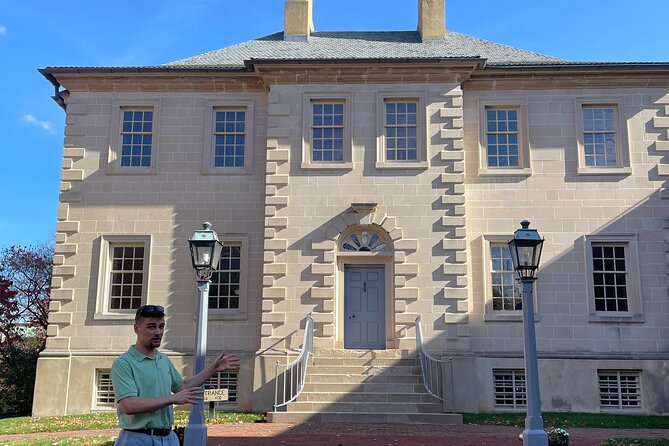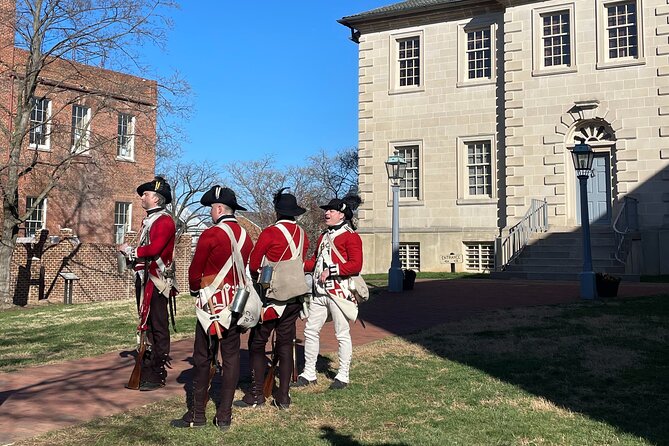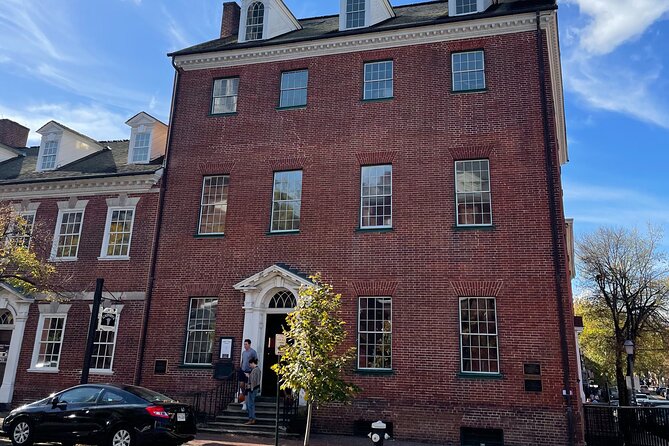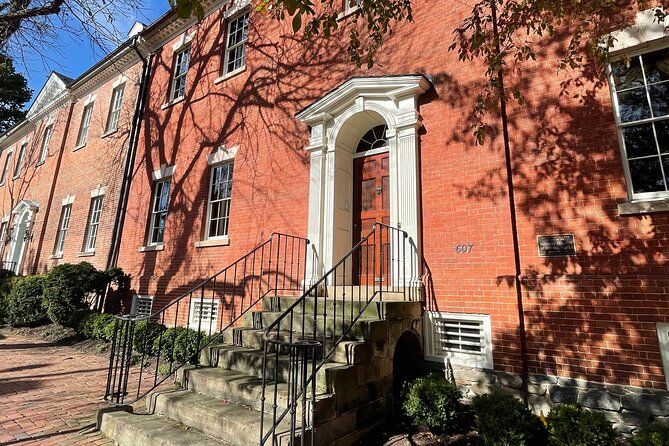Alexandria’s history is a captivating tapestry, woven with the threads of its prehistoric roots, colonial foundations, and pivotal moments during the Revolutionary and Civil Wars. From indigenous tribes thriving on the region’s abundant natural resources to the city’s emergence as a vital shipping hub, Alexandria’s story is one of resilience and transformation. Notably, the city maintained a close connection to President Abraham Lincoln, who frequently visited during the tumultuous Civil War era, leaving an indelible mark on its history. What other intriguing chapters await in this rich and multifaceted narrative?
Key Points

-
Alexandria’s history dates back thousands of years, with evidence of indigenous settlements and thriving communities dating as far back as 8,000 BCE.
-
The city was established in 1749 by the Virginia General Assembly, becoming a thriving colonial port attracting merchants and tradespeople.
-
During the Revolutionary War, Alexandria’s strategic location along major transportation routes made it an important shipping hub, with residents divided in loyalties.
-
The onset of the Civil War in 1861 transformed Alexandria’s trajectory, with the city experiencing Union occupation and martial law, disrupting the local economy.
-
Alexandria’s close ties to President Abraham Lincoln during the Civil War era are reflected in historic sites and museums throughout the city.
Prehistoric Settlements and Indigenous Tribes

Alexandria’s history traces back to the time before European settlers arrived in the region. The area was home to various indigenous tribes, including the Piscataway, Pamunkey, and Powhatan confederacies.
These groups thrived on the abundant natural resources and fertile lands of the region for thousands of years. Archaeological evidence suggests that prehistoric settlements in the area date back as early as 8,000 BCE, with the discovery of stone tools and other artifacts.
The indigenous people lived in harmony with the land, developing sophisticated agricultural and hunting practices that sustained their communities. This rich history lays the foundation for Alexandria’s vibrant and diverse cultural heritage.
You can also read our reviews of more tours and experiences in Virginia.
Founding of Alexandria and Colonial Era

In 1749, the Virginia General Assembly authorized the hotel of the Town of Alexandria on the Potomac River. Located along major transportation routes, Alexandria quickly became a thriving colonial port. Its strategic position and growing wealth attracted merchants, ship captains, and skilled tradespeople.
During the Revolutionary War, Alexandria’s residents remained divided in their loyalties, but the town later prospered as part of the newly formed United States. Key figures like George Washington and Robert E. Lee had strong ties to Alexandria, shaping its history.
Revolutionary War and the Rise of Alexandria
During the Revolutionary War, Alexandria’s residents remained divided in their loyalties, with some supporting the patriot cause and others loyal to the British crown.
Despite these divisions, the town’s strategic location on the Potomac River made it an important shipping hub. In 1778, the town was briefly occupied by British troops, who confiscated supplies and goods.
After the war, Alexandria’s merchants and ship captains capitalized on the town’s newfound independence, and the local economy began to thrive.
The rise of Alexandria in the late 18th century transformed the once-sleepy colonial town into a bustling center of commerce and trade, setting the stage for its growth in the 19th century.
Antebellum Alexandria and the Civil War

As the 19th century unfolded, Alexandria’s prominence as a commercial hub along the Potomac River continued to grow. During this antebellum era, the city’s economy thrived, fueled by its strategic location and bustling port.
However, the onset of the Civil War in 1861 would forever change the course of Alexandria’s history. The city’s proximity to Washington, D.C. and its position as a key transportation node made it a target for Union occupation.
This resulted in:
- Martial law being declared.
- The city becoming a staging ground for Union troops.
- The suspension of civil government.
- The disruption of the local economy.
The scars of the Civil War would linger long after the conflict’s end, shaping Alexandria’s future in profound ways.
Reconstruction and Industrial Growth

Following the tumultuous era of the Civil War, Alexandria gradually transitioned into a period of reconstruction and industrial growth.
The city’s strategic location along the Potomac River and proximity to the nation’s capital made it an attractive hub for manufacturing and commerce. Factories producing textiles, steel, and other goods began to dot the landscape, while the city’s port facilitated the export of these products.
The arrival of the railroad further bolstered Alexandria’s economy, connecting it to markets across the country. This industrial boom transformed the city, ushering in an era of prosperity and population growth that would continue well into the 20th century.
- Luxury Tours of Mount Vernon
- Private Customized Tour of Washington DC With US Veteran
- Visit Mount Vernon by Bike: Self-Guided Ride With Optional Boat Cruise Return
- Kayak Tour Along Assateague & Chincoteague Island, Virginia
- Escape Room Live Alexandria: 60-Minute Adventures
- Small-Group Sunset Boat Tour Around Chincoteague & Assateague Islands
The Gilded Age and Architectural Legacy

With the end of the Civil War, Alexandria entered a new era known as the Gilded Age. The city experienced rapid growth and development, marked by a surge in architectural innovations.
Key features of this period include:
-
The construction of grand, ornate buildings that showcased the city’s newfound wealth and prosperity.
-
The emergence of iconic landmarks, such as Gadsby’s Tavern, which became an integral part of Alexandria’s cultural heritage.
-
The preservation of historic structures, highlighting the community’s efforts to maintain its unique character.
-
The rise of prominent local architects who left an indelible mark on the city’s skyline.
This architectural legacy continues to shape Alexandria’s identity, preserving its rich history and charm.
Twentieth Century Transformations

The 20th century ushered in a transformative era for Alexandria, as the city adapted to the changing economic and social landscape. Factories and warehouses replaced traditional shops, and the city’s African American community grew in size and influence.
Desegregation efforts in the 1950s and 1960s sparked tensions, but ultimately led to greater inclusion. In the 1970s, historic preservation initiatives helped revitalize Old Town, drawing travelers and new residents.
Today, Alexandria blends its rich past with modern amenities, offering visitors a unique glimpse into the city’s evolution. From its colonial roots to its dynamic present, Alexandria’s history continues to shape its identity as a vibrant, diverse community.
Alexandria’s Connection to Abraham Lincoln

Alexandria’s long history is closely intertwined with that of President Abraham Lincoln.
As the capital of the Confederacy during the Civil War, Alexandria played a significant role in the conflict. Lincoln visited the city on multiple occasions, including when he:
- Reviewed troops stationed there.
- Inspected military hospitals caring for wounded soldiers.
- Attended religious services at Christ Church, where he worshiped during his visits.
- Paid respects to those who lost their lives in the struggle.
Today, Alexandria’s historic sites and museums offer visitors a glimpse into the city’s connection to this pivotal American figure and the turbulent era he helped define.
Frequently Asked Questions
What Are the Tour’s Departure and Return Times?
The tour doesn’t have specific departure and return times. It’s a guided walking tour that starts at the Alexandria Visitor Center and ends at Gadsby’s Tavern, with the duration depending on the pace of the group.
Are Audio Guides or Headsets Provided During the Tour?
No, audio guides or headsets are not provided during the walking tour. The guide leads the group and provides live commentary throughout the experience instead of using pre-recorded audio devices.
Can I Bring My Own Food and Drinks on the Tour?
According to the tour details, visitors are not permitted to bring their own food and drinks on the guided walking tour. The tour focuses on historical sites, and the admission fees cover access to museums during the experience.
Is Photography Allowed During the Tour?
Photography is generally allowed during the tour, though the guide may ask visitors to refrain from taking photos in certain historic locations. Participants are encouraged to capture the sights and scenes of the walking tour at their discretion.
Do I Need to Purchase Tickets in Advance for the Museums?
No, you don’t need to purchase museum admission tickets in advance. The tour includes these fees, so you can simply join the group and enjoy the historical sites during the walking tour.
Recap
Alexandria’s rich history is a tapestry of resilience, as the city navigated periods of conflict, growth, and transformation. From its prehistoric roots to its close ties with Abraham Lincoln, Alexandria’s story embodies the enduring spirit of a community that has adapted and thrived through the centuries. Its architectural legacy and industrial progress reflect the city’s enduring influence, making it a testament to the resilience of the human spirit.
More Tour Reviews in Virginia
- 4-Hour Fishing Skiff Boat Rental in Chincoteague Island, VA
- Cheeseology Un-brie-lievable Wine Pairings and Cheesy Wisdom!
- Smith Mountain Lake Weekly Ebike Rental With Delivery
- Self Guided Walking Tour in Alexandria Review
- 8-Hour Pontoon Boat Rental Review
- 2-Hour Sunset Skiff Boat Rental in Chincoteague Island, VA
Not for you? Here's more things to do in Virginia we have recnetly reviewed
- 9 Best Cruises And Boat Tours In Virginia
- 2 Best Food Tours In Virginia
- Arrival Private Transfer: Dulles Airport IAD to Washington in Luxury SUV
- Private Airport Transfer: Dulles Airport IAD to Washington in Luxury SUV
- Private Arrival Transfer: Dulles Airport to Washington DC (any Hotel or Address)
- Washington Dulles Airport (IAD) to Washington – Arrival Private Transfer
- Monday Art Party
- Private Horseback Experience in Appalachian Mountains
- Chincoteague Dolphin Watching Boat Tour
- 2-Hour Sunset Pontoon Boat Rental in Chincoteague Island, VA
- Kayak Rental on Shenandoah River in Luray Virginia
- Chincoteague E-bike Tours
